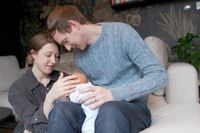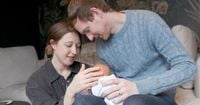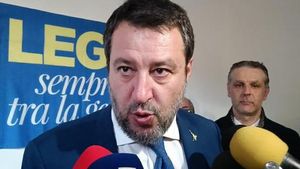A baby girl has made history as the first child in the UK to be born from a womb transplant. Grace Davidson, 36, underwent the first such transplant in the UK in 2023, receiving the organ from her older sister Amy. Following the success of the procedure, she has given birth to baby Amy Isabel, named after her aunt, a surgeon who helped perfect the technique. The birth marks a significant advancement in reproductive medicine, potentially transforming the lives of thousands of women born without a functioning uterus.
Baby Amy Isabel Davidson was born via planned NHS Caesarean section on February 27, 2025, at Queen Charlotte’s and Chelsea Hospital in London. Grace and her husband, Angus Davidson, 37, expressed their overwhelming joy at the arrival of their daughter. Mrs. Davidson said she felt “shock” when she first held her daughter, adding, “We have been given the greatest gift we could ever have asked for.”
Mrs. Davidson, an NHS dietitian, was born with Mayer-Rokitansky-Küster-Hauser (MRKH), a rare condition that affects around one in every 5,000 women, meaning they have an underdeveloped or missing womb. However, the ovaries are intact and still function to produce eggs and female hormones, making conceiving via fertility treatment a possibility. Before receiving the donated womb, Grace and Angus underwent fertility treatment to create seven embryos, which were frozen for IVF in central London.
In February 2023, Grace Davidson had surgery to receive the womb from her sister Amy Purdie, 42, a former primary school teacher and mother of two girls aged 10 and six. Several months later, one of the stored embryos was transferred via IVF to Mrs. Davidson. Baby Amy, who weighed 4.5lb at birth, was delivered several weeks early in the planned 90-minute Caesarean section to ensure a safe, hospital-based delivery. The couple's journey highlights the remarkable potential of womb transplantation to address uterine factor infertility.
The new mother said, “The first couple of weeks were tricky because she was so sleepy, and we were struggling to kind of keep her awake enough for her feed, but she’s doing really well.” She added, “She had a bit of jaundice to start with, and she needed a bit of light therapy, but she’s a stronger feeder now, and she’s more alert.”
Mr. Davidson described the moment his daughter arrived as very emotional. “She came out crying, and we were a bit worried she would be whisked off to an antenatal ward, but she’s been with us every minute of her life, so we’re so grateful for that,” he said. “It had been such a long wait. We’d been intending to have a family somehow since we were married, and we’ve kind of been on this journey for such a long time.”
He continued, “The room was full of people who have helped us on the journey to actually having Amy. We had been kind of suppressing emotion, probably for 10 years, and you don’t know how that’s going to come out – ugly crying it turns out! The room was just so full of love and joy.”
Mrs. Davidson said the couple always had “a quiet hope” that the womb transplant would be a success. “It was quite a long run up to the transplant, maybe eight years or so, and we kept thinking it might get ruled out for various reasons,” she said. “But once we had the transplant, I think we were hopeful that things were going to work out.”
She added, “Lots of womb transplants fail in the first two weeks, so even just to get to that point was amazing, and having my first period was really amazing because it showed it was working. What helped us through the tough times was sort of thinking this is all going to be worth it… I’m so grateful, it’s given us so much.”
Mrs. Purdie, who lives in Scotland, was not at the birth but was only a phone call away. She said, “Watching Grace and Angus become parents has been an absolute joy and worth every moment.” Mrs. Purdie did not hesitate to think about donating her womb to her younger sister once the living donor transplant program became a possibility. “It was very natural,” she told PA.
Grace Davidson was diagnosed with MRKH when she was 19 and found out about womb transplants at the same time. “It was very much at the research stages, but the consultant said this might be available in my lifetime,” she said. “The year before we got married, I just sort of Googled it and found out there was a research team, and there was an email address, so I emailed them.”
She explained, “We basically got recruited from 800 women down to 10, I think, and that was purely for the deceased donor trial. We were on that for maybe three years, and then the living donors really took off as a possibility.”
The lead surgeons for the womb transplant were Professor Richard Smith, clinical lead at the charity Womb Transplant UK, and Isabel Quiroga, consultant surgeon at the Oxford Transplant Centre, part of Oxford University Hospitals. Prof. Smith, who led the development of womb transplants in the UK, shed tears at the birth. He said, “I feel great joy actually, unbelievable – 25 years down the line from starting this research, we finally have a baby, little Amy Isabel. Astonishing, really astonishing.”
Miss Quiroga expressed her delight, stating, “For me, it’s total joy, delight. I couldn’t be happier for Angus and Grace, what a wonderful couple. It was overwhelming actually, it remains overwhelming. It’s fantastic.”
Womb Transplant UK has carried out four womb transplants in the UK – the first on Mrs. Davidson and then three on women who received wombs from deceased donors. The breakthrough in the procedure was in Sweden in 2014 when the first baby, a boy named Vincent, was born after his mother had a womb transplanted from a close family friend. Dr. Mats Brännström, of Sahlgrenska Academy at the University of Gothenburg, forecast that womb transplants could be offered to a much wider group of women who have lost their womb after suffering cancer or other diseases.
The birth of baby Amy Isabel marks a pivotal moment in reproductive medicine, offering hope to many women facing similar challenges. As experts continue to explore the possibilities of womb transplantation, the Davidson family’s story serves as a beacon of hope for countless others.






